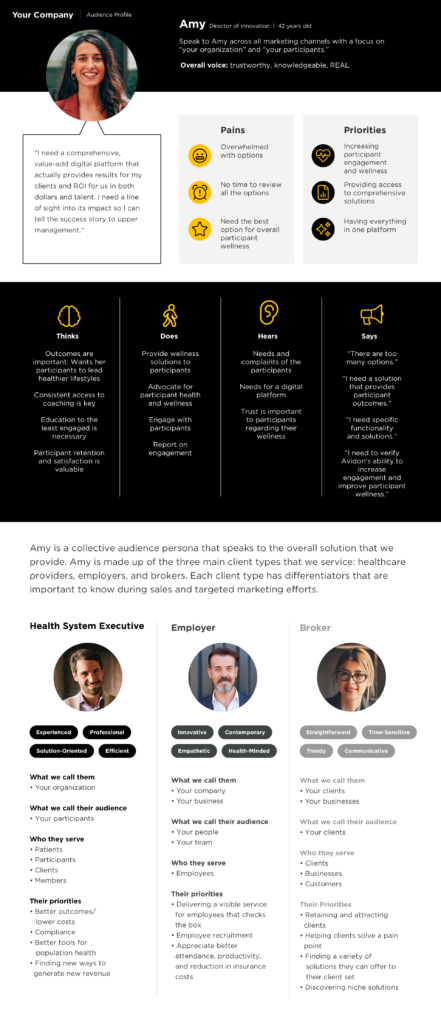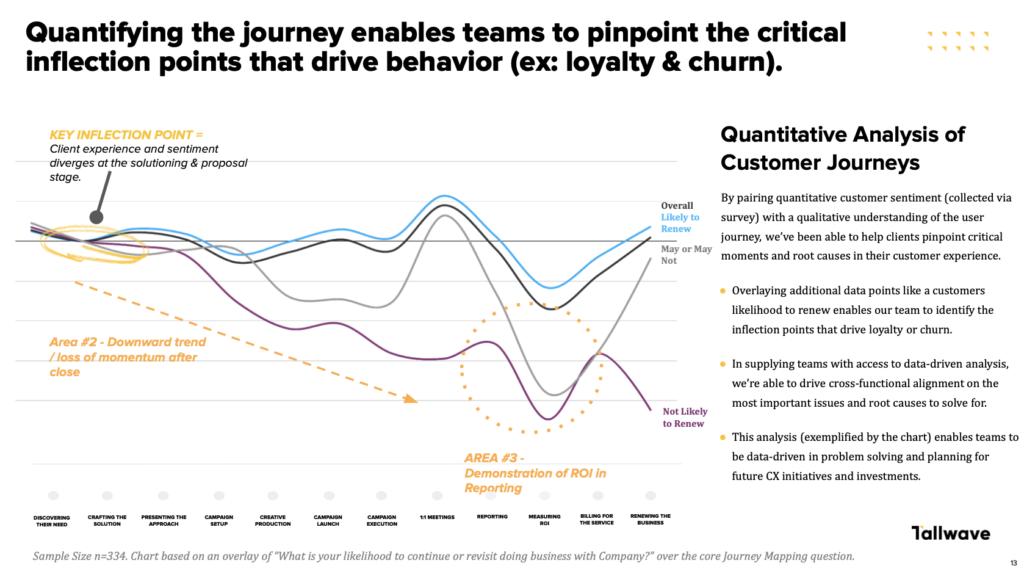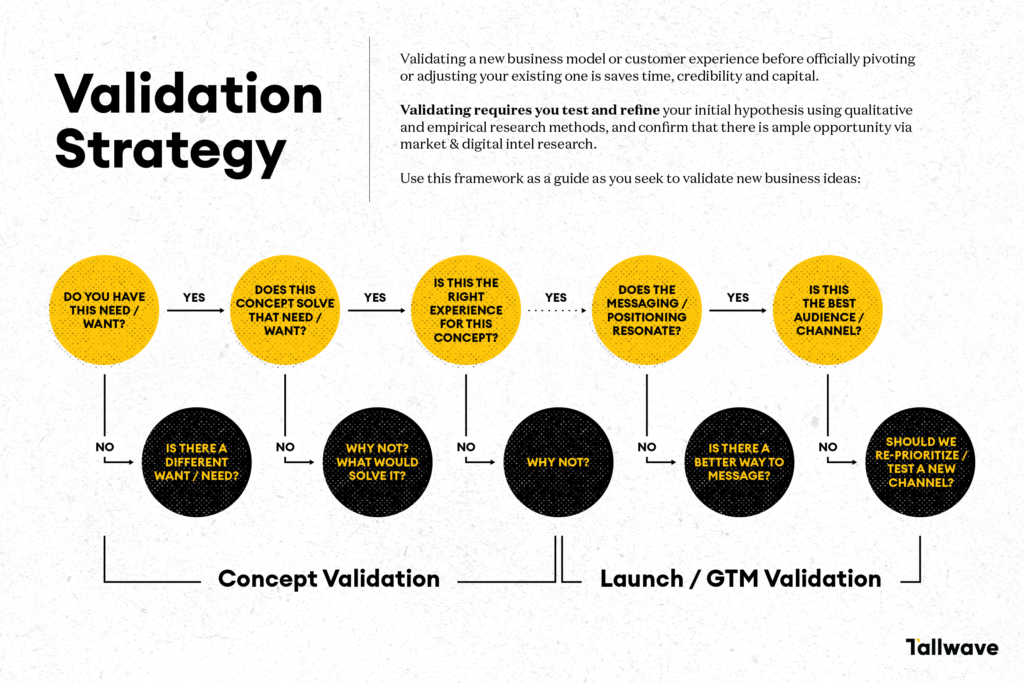The Women in the Workplace 2021 report from Lean In and McKinsey & Co. highlighted that all the slow but measurable gains women have made in all levels of management could be wiped out in a single year by the disproportionate impact that COVID-19 has had on women in the workplace. In fact, the report finds that more than one in three women may downshift or leave their careers as a result. This impact is compounded for working mothers, particularly those with young children, who feel scrutinized for taking advantage of options that make balancing work and the demands of home and family easier and are less likely to feel comfortable sharing their personal struggles with others.
More than one in three women may downshift or leave their careers as a result of the disproportionate impact that COVID-19 has had on women in the workforce.
At Tallwave, we believe experience is everything. Employee and customer experiences are inextricably linked—great employee experience is a key driver of great customer experience. It’s impossible to sustain one without the other. Conversely, when companies create employment experiences that fail women, they’re setting themselves up to fail their customers. With women making up 51% of the overall population and 57.8% of the labor force, losing ground on female representation in the workplace could have devastating effects. The state of our female workforce hangs in the balance, and with it, the health of the companies that depend on their valuable contributions.
Also read: Crafting Employee Experiences That Improve Customer Experiences
Here at Tallwave, 54% of our employees are women, which means more than half the work taken on by our company—and more than half of the value we create for clients—is in the hands of women. As a customer experience design company, it’s important for us to both reflect on the experiences we’re creating for the women among our own ranks and to serve as a thought leader for brands that recognize the unbreakable link between EX and CX. So we did something far too few companies do. We invited a group of working mothers at Tallwave to get together for a discussion facilitated by our VP of Marketing, a working mother of three herself, to share their perspectives on what’s working within employment experience for working mothers, what’s not, and the recommendations they have to help companies better support women.
Create Space for Employees to Bring Their “Whole Selves” to Work
The idea of needing to give employees an invitation to be who they are at work may seem startling, but what we discovered from our group of Tallwave moms was that the ability to bring your “whole self” to work, including sharing the demands you face at home and the need to harmonize them with the demands of work, is not a given. For Martha Schulzinger, a program manager at Tallwave and mother of two, the ability to be her authentic self at work isn’t something she takes for granted. “Tallwave has proven time and time again that I can be my authentic self and I won’t be shunned for it. I’ve worked in some pretty toxic places where you can’t bring your whole self to work and it’s a constant struggle.”
Her experience in an environment that embraces her entire identity, including the demands of motherhood, has also led to deeper bonds with colleagues and even clients who have seen her in “mom mode.” “Being able to be your authentic self and knowing the people you work with aren’t going to judge you if you have a kid there with you in the room has been kind of magical. My teammates have seen my kids grow up. Even some of our clients have seen my three-month-old become a two-year-old. They’ve seen him grow as he’s come in and out of the screen, and that’s pretty neat.”
But Martha acknowledges that openly sharing the demands she’s juggling at home wasn’t necessarily something she was immediately willing to do, and she credits colleagues, particularly Senior Consultant and fellow mother of two, Erin Nielsen, with helping her find the courage to be more open about the challenges she faces as a working mom. “Erin has been a role model for me. In the very early days of the pandemic, she had her kids on camera and I was very afraid to do that. But she showed up like a total boss, just owning whatever it was that she needed to talk about. She was present, then the kids would come in, she’d handle them, and come right back to whatever she was doing without skipping a beat. And I was like, ‘Okay, I can do that, too.’ I’m really thankful to her for that.”
For Erin, it was simply a question of what she was and wasn’t willing to sacrifice as the pandemic caused her personal and professional worlds to collide. “When I realized we weren’t going to be home for two weeks and then go back to the office, I took a step back and asked myself, ‘How do I want to act through this?’ I wasn’t willing to sacrifice my kids’ happiness and pretend they weren’t here so I could keep working. I don’t think I made a conscious decision to test my company, but I’m a mom first and I’m never going to not be.” She decided it wasn’t worth pretending her reality was anything other than it was. “I chose to be my authentic self. And if I got pushback or didn’t feel safe, then I’d know I wasn’t in the right place and that it was time to move on. And I found what I was hoping I’d find, which was a supportive group of people, which was really cool to see.”
Recommendation from the Moms: In both Martha’s and Erin’s cases, their decisions to stop trying to hide what was happening at home wasn’t inspired by overt assurances of support and acceptance, even though that’s ultimately what they found in their colleagues. So what’s the takeaway for companies trying to do better for moms? Don’t assume the mothers in your employ feel welcome to bring their whole selves to work if you haven’t made the invitation. If employees aren’t being explicitly encouraged to be open about how their personal lives impact work or at least seeing leadership model the choices they’re making to balance these often competing demands, they may assume they won’t be supported if they do.
Know the Difference between Sympathy and Empathy and the Value of Both
While experiencing the sympathetic support of colleagues and managers was a common theme for all the Tallwave moms in our conversation, so was the desire for the kind of empathetic support that shared experience creates. Overwhelmingly, they felt genuinely supported by their direct managers. But in many cases, their direct managers had never been working mothers themselves. As working moms, they craved support from others who’d shared their experiences and they’ve been grateful to find it in other colleagues outside their direct reporting structures. Looking back on her professional experience prior to having children, Erin acknowledged the limitations of her own understanding. “You just don’t get it when you’re not a parent. I certainly didn’t get it, and I put my foot in my mouth plenty of times before I was a parent.”
Experiential empathy creates deeper understanding, but it can also inspire hope. Many working mothers perceive their career goals, what it takes to achieve them, and how much they can afford to give as incompatible. But having access to other women who have grappled with the demands of working motherhood helps them challenge their own perceptions. This was especially meaningful for Sierra Dommin, Business Analysis Manager at Tallwave. “That statistic about more than one in three women putting their career aspirations on hold really spoke to me. I really want to take the next step in my career and it’s not that I don’t think I have that opportunity at Tallwave. It’s that I don’t feel like I can seize it right now because my kids are so young and I just don’t know how to balance it all. I feel like I’m hanging on by a thread. I feel like I have to just stick it out because adding another stressor to my plate will tip me, and my family will suffer. These two things that are both so important to me seem impossible to reconcile. It makes me feel stuck and it’s really frustrating.” But hearing the experiences of other working moms, particularly those who were further into their motherhood journeys, made her feel more optimistic. “Where I am with my kids and my career, just seeing someone else who’s been through it brings relief. Knowing that others have faced similar challenges and that they’re still here gives me hope.”
For working mothers, being fully present for your family and fully engaged in your family feel like binary choices. And no matter which you make, you end up on the losing end. For Martha, the cost of leaning into her career is guilt. “I’m so happy to be at Tallwave and to have challenges in front of me in my career. It’s everything I’ve ever dreamed of. But every night I go to bed with so much guilt because I’m not present with my children. I work from home and they’re right here with me. They want me to play with them and I can’t because I’m working. I go to bed early so I can have a few hours of productive work time before the kids get up, so I’m mentally drained and too exhausted to do anything for myself.”
As Martha is quick to point out, it’s not that her colleagues aren’t supportive. Many simply don’t share her experience. “My coworkers are amazing and I love them. But there’s just no way for them to fully understand. In between meetings, maybe they refresh their cup of coffee but I’m changing blow-out diapers. As much as I want to give more to my work, I’m also giving so much at home that there’s just nothing left.” This strikes a chord with Erin, too. “I adore my coworkers, all of them. And I’ve been pleasantly surprised by how those who don’t have children have come to the table. But you just don’t get it if you’re not in it. Talking to other moms who have confronted the same things we’re facing—putting up boundaries, finding your own happiness, living through the endless juggle of work and family—these little nuggets go such a long way.”
Recommendation from the Moms: Access to other women striving to harmonize careers and families is an incredibly powerful tool for working mothers. Awareness of other working mothers—particularly those in leadership positions—improves visibility, empowering working moms to feel more seen, heard, and represented. The ability to discuss the shared experience of working motherhood helps working moms find support, seek advice, and draw inspiration. For working mothers whose direct supervisors don’t share their experience, it’s particularly important to provide other paths of access, like employee resource groups, mentorship programs, organized meet-ups, and discussion forums.
Recognize that Making Work Better for Women Isn’t Women’s Work
For women who are accustomed to serving as constant problem solvers on the home front, solutioning, actioning, and accommodating may come naturally. But far too often, companies are content to let working moms solve their workplace problems alone, starting with the transition from maternity leave.
While some of the mothers who participated in our conversation had employers who created comfortable places for new moms to pump, that was generally the extent of the effort their past companies put into helping them successfully navigate workforce re-entry. Reflecting on her returns to work after having her two children, Erin’s experience aligned to those of virtually everyone else on the call. “You come back and you’re stressed out and that never stops because you’re trying to figure out how to be a first-time mother, and then a mother of two or three or more on top of everything else. And it’s always on you to figure it out and you just don’t feel like there’s any support there. You’re expected to perform at the exact same level while you’re trying to find time to pump or nurse. You’re forced to start making choices between meeting work expectations and the expectations you had for how you’d care for your baby. And those forced choices never stop.”
As companies look to advance their goals and initiatives, supported in large part by working mothers, they rarely consider the personal impact of the work that working moms must take on. For Chelsey Gloetzner, Product Design Manager at Tallwave, she recognizes that fully embracing the work that excites her may come at a personal cost. “We have a lot of women in leadership, which is fantastic. As we’re pursuing large goals, a lot of moms are doing the work. I recognize my responsibilities in supporting our goals as a manager, and I’m pumped to do it. But I also don’t want to put in an extra two hours every single night to get projects over the line and miss my kids’ childhoods. As companies set goals, they need to recognize how the associated work trickles down to parents.”
As Erin is quick to note, the trickle-down responsibilities don’t just come from companies’ revenue and growth goals—culture-building initiatives are often disproportionately driven by women. In fact, the Women in the Workplace 2021 report finds that compared to men at the same level, female managers take more supportive actions with their teams, helping them manage workloads and keeping a pulse on their overall wellbeing. The report also finds that women in senior-level positions are twice as likely as male counterparts to spend substantial time beyond their normal job responsibilities on diversity, equality, and inclusion initiatives. Throughout her career, Erin has seen not just women, but in many cases working mothers, step up to the plate more than their fair share. “Ensuring our teams are coming together, that people feel rewarded, that there’s a balance of face time and fun activities in our work and that company culture is being strengthened, all those types of activities that keep the ship afloat are often led by mothers because we care and naturally step up. But we can’t keep bearing the brunt of treating the office like our family. We have nothing else to give.”
Compared to men at the same level, female managers take more supportive actions with their teams, helping them manage workloads and keeping a pulse on their overall wellbeing. Women in senior-level positions are also twice as likely as male counterparts to spend substantial time beyond their normal job responsibilities on diversity, equality, and inclusion initiatives.
Recommendation from the Moms: With women making up well over half of the workforce, companies must recognize that every business decision they make will inevitably impact women. And for the working mothers among them, the impact may be much more difficult to absorb. It’s important to recognize that barriers to success for working mothers are barriers to success for their companies, and they should be treated that way. That means rather than leaving working mothers to fend for themselves in an inhospitable working environment, companies should be enlisting allyship from across their ranks to create an environment that better supports them. This can include things like:
- Confronting gender bias head on. From addressing big-picture issues—like equal pay and advancement—to challenging common daily implicit biases by resisting an overreliance on women to fulfill administrative and culture-building duties, and addressing overt sexism in the moment, a better workplace for working mothers starts with a better workplace for women in general.
- Investing in allyship development programs to drive awareness of and support for women in general and working mothers especially.
- Training managers in active listening and leadership techniques to better equip them to not just listen but to seek to understand what working mothers need to help them succeed in their careers.
- Considering the disproportionate burden of emotional labor that women face in company decision making. With women carrying greater responsibility for household chores and caretaking than men, scheduling meetings over lunch, allowing meetings to run late, or requiring sustained >40 hour work weeks will have a bigger impact on working mothers than their counterparts.
- Institutionalize support as much as possible and model utilization at the leadership level. Offering things like flexible work schedules, child care, parental leave, job sharing options, and parental leave reintegration support can go a long way toward creating a more hospitable environment for working mothers. Seeing those supports used by company leaders sends an even stronger message.
- Actively advocate for moms transitioning back to work after maternity leave. The difference between passive support for new mothers to “take the time they need” and actively supporting them through formal programs and resources can be transformational for new mothers returning to work. Companies that know, attend to, and proactively advocate for the rights of working mothers under the Family & Medical Leave Act and Fair Labor Standards Act by helping them become more knowledgeable about their rights and having defined programs and/or policies in place for things like altered work schedules and appropriate pumping/nursing accommodations will be at a significant advantage in keeping working mothers engaged and retaining them over time.
Final Thoughts
No company succeeds by leaving women behind. While that’s rarely the intent, it’s the inevitable result of not taking deliberate action. At Tallwave, creating an inclusive culture for all employees, including working mothers, has been an ongoing focus. Like most companies, we know we still have work to do. But the fact that this group of Tallwave moms felt safe sharing their experiences, perspectives, and recommendations openly wasn’t the result of simply inviting them to. This kind of open exchange is possible because we make deliberate choices to create an environment where employees feel safe speaking up. Maintaining this kind of culture takes conscious, continuous effort, but it’s an investment we know is well worth making.
Companies that create supportive, empowering employment experiences for working mothers not only unlock greater potential from their workforces than those that don’t, but they also unleash an incredibly diverse and powerful set of skills. After all, few experiences are as effective at developing the kind of patience, creativity, resourcefulness, problem solving, critical thinking, negotiation, diplomacy, tenacity, optimism, and commitment that motherhood requires. And few customers are as unreasonably demanding as children. By creating the conditions that help working mothers succeed in the workplace, companies just might discover that the key to unlocking their own potential has been there all along.
Special Thanks
Tallwave would like to thank the incredible working mothers below who shared their perspectives for this piece and all the women of Tallwave whose efforts are instrumental in our success and the success of our clients.
Caroline Meehean
Chelsey Gloetzner
Erin Nielsen
Jen Bonfilio
Jes Pumo
Martha Schulzinger
Sierra Dommin









